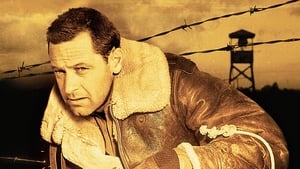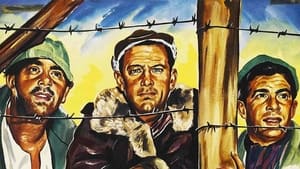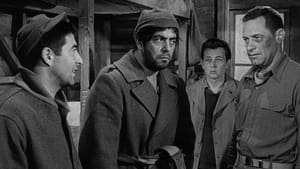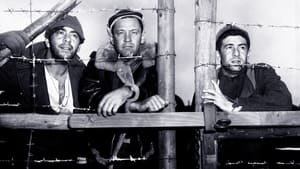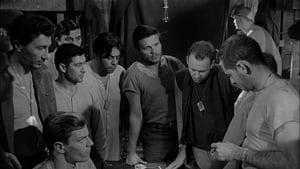Contact: [email protected]
Video Sources 0 Views

Synopsis
[ez-toc]




Introduction
In the ever-evolving landscape of cinema, certain classics stand the test of time, captivating audiences across generations. One such gem is “Stalag 17 Colorized,” a 1953 film directed by the legendary Billy Wilder. Recently, the cinematic world has witnessed a resurgence of interest in this classic, particularly with the release of a colorized version. In this article, we delve into the captivating story, explore the brilliant minds behind its creation, and discuss the controversial yet fascinating realm of colorization in film restoration.
Read Media File Transfer Agreement: Terms and Conditions
Read FAQ
The Story of Stalag 17 Colorized
Set against the backdrop of World War II, “Stalag 17 Colorized” unfolds within the confines of a German prisoner-of-war camp. Billy Wilder, known for his eclectic filmography, skillfully directs this tale of camaraderie, suspicion, and the indomitable human spirit. The film stars William Holden, who delivers a remarkable performance that earned him an Academy Award.
The plot revolves around a group of American airmen incarcerated in Stalag 17 Colorized, each coping with the challenges of captivity in their own way. Tensions rise as suspicions mount, leading to a gripping narrative that keeps viewers on the edge of their seats. The film’s historical context and vivid characters add layers of depth, making it a standout in the war film genre.
The Brilliant Mind Behind Stalag 17 Colorized
At the helm of this cinematic masterpiece is the ingenious Billy Wilder. Known for his versatility in tackling various genres, Wilder brings his signature touch to “Stalag 17 Colorized.” His keen directorial eye and ability to blend humor with poignant storytelling shine through, creating an unforgettable viewing experience.
Adding to the film’s brilliance is Otto Preminger, not in the director’s chair this time but as a pivotal actor within the ensemble cast. Preminger’s contribution to the film, both in front of and behind the camera, adds a layer of complexity to the characters and their interactions.
Understanding Colorization and Its Role in Film Restoration
In recent years, the film industry has witnessed a resurgence of interest in colorizing classic black-and-white movies. This process involves digitally adding color to enhance the visual experience for modern audiences. While purists argue that it compromises the artistic integrity of the original work, others see it as a way to breathe new life into timeless classics.
The colorization process has evolved significantly, employing advanced techniques to ensure a seamless transition from grayscale to vibrant hues. This innovation has sparked debates within the industry about the merits and drawbacks of altering the original vision of filmmakers.
The Controversy Surrounding Colorizing Classic Movies
Enter the controversy surrounding the colorized version of “Stalag 17 Colorized.” Purists argue that the film’s essence lies in its black-and-white cinematography, capturing the stark realities of war in a visually striking manner. On the other hand, proponents of colorization contend that it allows new audiences to connect with these classics on a deeper level, bridging the gap between the past and present.
This debate raises crucial questions about preserving the artistic intent of filmmakers while making classic cinema more accessible to contemporary viewers. The clash between tradition and innovation adds an intriguing layer to the narrative surrounding “Stalag 17 Colorized.”
Examining the Impact of Color on Stalag 17’s Visual Narrative
The colorized version of “Stalag 17 Colorized” introduces a new dimension to the viewing experience. Peter Graves, among the ensemble cast, takes on a renewed presence as the vivid hues breathe life into the characters and surroundings. This prompts an exploration into how colorization enhances or detracts from the film’s storytelling.
Comparisons between the original black-and-white version and the colorized rendition reveal nuances that may have been overlooked in the monochromatic presentation. The use of color to depict the harsh realities of war, the camaraderie among prisoners, and the tension within Stalag 17 Colorized invites viewers to appreciate the film from a fresh perspective.
Preserving Cinematic Gems: The Role of Restoration in Honoring Film Legacies
Colorization is just one facet of the broader field of film restoration. Preserving classic movies involves various techniques, from cleaning and digitizing original prints to restoring damaged frames. While colorization aims to make films more visually appealing to modern audiences, other methods focus on maintaining the authenticity of the original work.
Case studies of successfully restored films underscore the importance of preserving cinematic history. By employing cutting-edge technology and meticulous attention to detail, restoration experts breathe new life into old classics, ensuring they remain accessible to future generations.
The Enduring Value of Stalag 17 Colorized: Themes, Performances, and Accolades
“Stalag 17 Colorized” transcends its wartime setting, blending comedy, suspense, and dramatic tension with an ironic sensibility. The film’s exploration of humor amidst the harsh realities of war adds a layer of complexity, engaging audiences on multiple levels. William Holden’s Oscar-winning performance as J.J. Sefton becomes a linchpin, anchoring the narrative and leaving an indelible mark on cinematic history.
The seamless integration of different genres within “Stalag 17 Colorized” showcases Billy Wilder’s directorial prowess. The film’s ability to balance laughter and tension, creating a unique brand of dark comedy, contributes to its enduring legacy. The Academy Award recognition further solidifies its place among the pantheon of cinematic greats.
Unforgettable Plot Twists: The POW Escape and German Informant Revealed
At the heart of “Stalag 17 Colorized” lies a riveting plot twist that elevates the narrative to new heights. The revelation of a traitor within the prisoner camp adds layers of suspense, as the characters grapple with betrayal in the midst of their captivity. The meticulously crafted plot twist remains etched in the minds of viewers, a testament to the film’s ability to subvert expectations and keep audiences guessing until the final frame.
The Legacy Lives On: Why Stalag 17 Colorized Remains Essential Viewing
Decades after its initial release, “Stalag 17” continues to resonate with audiences worldwide. Its exploration of human resilience, the bonds formed in adversity, and the price of loyalty transcends its wartime setting. The film’s legacy lies not only in its critical acclaim but also in its ability to connect with viewers on a profound and emotional level.
As we revisit “Stalag 17 Colorized” in its colorized form, the film’s enduring themes take on a new vibrancy. The decision to colorize, while met with controversy, opens the door for a new generation to appreciate the timeless tale of survival, friendship, and sacrifice.
Where to Experience Stalag 17 Colorized: DVD Purchase and Streaming Options
For those eager to embark on this cinematic journey, “Stalag 17 Colorized” is readily available for home viewing. The colorized version, aimed at modern audiences, offers a unique perspective on a classic masterpiece. Whether through DVD purchase or streaming options, viewers can choose the format that best suits their preferences, allowing them to witness the film’s brilliance in the comfort of their homes.
Conclusion
In the realm of cinema, “Stalag 17 Colorized” stands as a testament to the enduring power of storytelling. As we navigate the controversy surrounding the colorization of classic movies, it becomes evident that the heart of these narratives transcends the medium through which they are presented.
Encouraging readers to explore both the original black-and-white and colorized versions of “Stalag
The Story of Stalag 17 Colorized
Set against the backdrop of World War II, “Stalag 17 Colorized” unfolds within the confines of a German prisoner-of-war camp. Billy Wilder, known for his eclectic filmography, skillfully directs this tale of camaraderie, suspicion, and the indomitable human spirit. The film stars William Holden, who delivers a remarkable performance that earned him an Academy Award.
The plot revolves around a group of American airmen incarcerated in Stalag 17, each coping with the challenges of captivity in their own way. Tensions rise as suspicions mount, leading to a gripping narrative that keeps viewers on the edge of their seats. The film’s historical context and vivid characters add layers of depth, making it a standout in the war film genre.
The Brilliant Mind Behind Stalag 17
At the helm of this cinematic masterpiece is the ingenious Billy Wilder. Known for his versatility in tackling various genres, Wilder brings his signature touch to “Stalag 17.” His keen directorial eye and ability to blend humor with poignant storytelling shine through, creating an unforgettable viewing experience.
Adding to the film’s brilliance is Otto Preminger, not in the director’s chair this time but as a pivotal actor within the ensemble cast. Preminger’s contribution to the film, both in front of and behind the camera, adds a layer of complexity to the characters and their interactions.
Understanding Colorization and Its Role in Film Restoration
In recent years, the film industry has witnessed a resurgence of interest in colorizing classic black-and-white movies. This process involves digitally adding color to enhance the visual experience for modern audiences. While purists argue that it compromises the artistic integrity of the original work, others see it as a way to breathe new life into timeless classics.
The colorization process has evolved significantly, employing advanced techniques to ensure a seamless transition from grayscale to vibrant hues. This innovation has sparked debates within the industry about the merits and drawbacks of altering the original vision of filmmakers.
The Controversy Surrounding Colorizing Classic Movies
Enter the controversy surrounding the colorized version of “Stalag 17.” Purists argue that the film’s essence lies in its black-and-white cinematography, capturing the stark realities of war in a visually striking manner. On the other hand, proponents of colorization contend that it allows new audiences to connect with these classics on a deeper level, bridging the gap between the past and present.
This debate raises crucial questions about preserving the artistic intent of filmmakers while making classic cinema more accessible to contemporary viewers. The clash between tradition and innovation adds an intriguing layer to the narrative surrounding “Stalag 17.”
Examining the Impact of Color on Stalag 17’s Visual Narrative
The colorized version of “Stalag 17” introduces a new dimension to the viewing experience. Peter Graves, among the ensemble cast, takes on a renewed presence as the vivid hues breathe life into the characters and surroundings. This prompts an exploration into how colorization enhances or detracts from the film’s storytelling.
Comparisons between the original black-and-white version and the colorized rendition reveal nuances that may have been overlooked in the monochromatic presentation. The use of color to depict the harsh realities of war, the camaraderie among prisoners, and the tension within Stalag 17 invites viewers to appreciate the film from a fresh perspective.
Preserving Cinematic Gems: The Role of Restoration in Honoring Film Legacies
Colorization is just one facet of the broader field of film restoration. Preserving classic movies involves various techniques, from cleaning and digitizing original prints to restoring damaged frames. While colorization aims to make films more visually appealing to modern audiences, other methods focus on maintaining the authenticity of the original work.
Case studies of successfully restored films underscore the importance of preserving cinematic history. By employing cutting-edge technology and meticulous attention to detail, restoration experts breathe new life into old classics, ensuring they remain accessible to future generations.
The Enduring Value of Stalag 17: Themes, Performances, and Accolades
“Stalag 17” transcends its wartime setting, blending comedy, suspense, and dramatic tension with an ironic sensibility. The film’s exploration of humor amidst the harsh realities of war adds a layer of complexity, engaging audiences on multiple levels. William Holden’s Oscar-winning performance as J.J. Sefton becomes a linchpin, anchoring the narrative and leaving an indelible mark on cinematic history.
The seamless integration of different genres within “Stalag 17” showcases Billy Wilder’s directorial prowess. The film’s ability to balance laughter and tension, creating a unique brand of dark comedy, contributes to its enduring legacy. The Academy Award recognition further solidifies its place among the pantheon of cinematic greats.
Unforgettable Plot Twists: The POW Escape and German Informant Revealed
At the heart of “Stalag 17” lies a riveting plot twist that elevates the narrative to new heights. The revelation of a traitor within the prisoner camp adds layers of suspense, as the characters grapple with betrayal in the midst of their captivity. The meticulously crafted plot twist remains etched in the minds of viewers, a testament to the film’s ability to subvert expectations and keep audiences guessing until the final frame.
The Legacy Lives On: Why Stalag 17 Remains Essential Viewing
Decades after its initial release, “Stalag 17” continues to resonate with audiences worldwide. Its exploration of human resilience, the bonds formed in adversity, and the price of loyalty transcends its wartime setting. The film’s legacy lies not only in its critical acclaim but also in its ability to connect with viewers on a profound and emotional level.
As we revisit “Stalag 17” in its colorized form, the film’s enduring themes take on a new vibrancy. The decision to colorize, while met with controversy, opens the door for a new generation to appreciate the timeless tale of survival, friendship, and sacrifice.
Where to Experience Stalag 17: DVD Purchase and Streaming Options
For those eager to embark on this cinematic journey, “Stalag 17” is readily available for home viewing. The colorized version, aimed at modern audiences, offers a unique perspective on a classic masterpiece. Whether through DVD purchase or streaming options, viewers can choose the format that best suits their preferences, allowing them to witness the film’s brilliance in the comfort of their homes.
Conclusion
In the realm of cinema, “Stalag 17” stands as a testament to the enduring power of storytelling. As we navigate the controversy surrounding the colorization of classic movies, it becomes evident that the heart of these narratives transcends the medium through which they are presented.
Encouraging readers to explore both the original black-and-white and colorized versions of “Stalag
